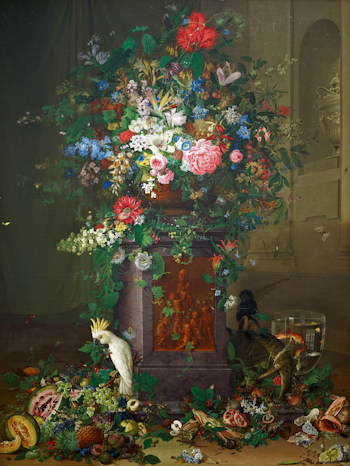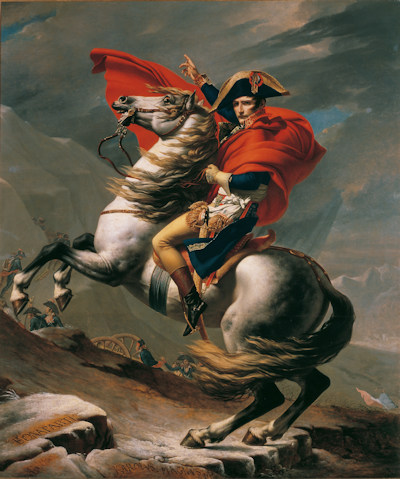
The west wing of Floor 1 of Upper Belvedere is decidedly un-Klimt: not a glimmer of Jugendstil gold to be seen. But it still has many treats for the innocent visitor…
- Portraits, landscapes, and more from the 17th to 19th centuries
- Look out for Jacques Louis David’s famous Napoleon portrait
- The Belvedere is a dynamic museum, so the actual works on display may vary
- All info in English and German
- Book Upper Belvedere tickets* online
- See also:
The exhibition

(Exhibition view Picture this! The Belvedere Collection from Cranach to EXPORT; photo: Johannes Stoll / Belvedere, Vienna)
As with the Upper Belvedere Klimt and Vienna 1900 displays opposite, the rooms here are arranged by chronological theme, drawing you through local art eras but also tackling topics such as the portrayal of war or court portraits.
Think of it as a gentle stroll through important periods in Austria’s art history, with a few special appearances. And always with an eye to explaining the evolution of art and the roles of artists within that change.
Here some of my personal highlights…
Eugene!

(Portrait of Eugene, Prince of Savoy by Jacob van Schuppen from 1718; photo courtesy of the Rijksmuseum)
The section begins with courtly portraits before showing, for example, how motifs then expanded and also became about the artist demonstrating their skill.
One such courtly portrait is of Belvedere’s original owner himself, Prince Eugene, on loan from the Rijksmuseum. So it would be remiss not to mention it.
The painting’s original title was Eugene: the man, the myth, the legend, the wig. (I so wish that was true.)
Glorious landscapes

(1758 landscape by Johann Christian Brand, oil on canvas; photo © Belvedere, Wien. Reproduced with permission under the terms of Creative Commons License CC BY-SA 4.0.)
Many of the subjects in the art presented also offer a glimpse into times past: whether court dress, family relations, local events or historical landscapes.
The mid-18th-century paintings by, for example, Johann Christian Brand caught my eye: particularly the flowing, jumbled nature of the pre-industrialised landscape. More curves and fewer lines than our modern farmland. And the better for it.
A cloned count?

(Homage to Jacquin by Johann Knapp, 1821-1822. Photo by Johannes Stoll and © Belvedere, Wien. Reproduced with permission under the terms of Creative Commons License CC BY-SA 4.0.)
In a 1760 painting of the family of Count Nikolaus Pálffy von Erdöd by Martin van Meytens the Younger (famous for his court and aristocratic portraits), the family appear to have alarmingly-similar faces.
No doubt an expert could likely explain this in terms of art history. But I choose to think that Count Nikolaus (or his wife) was particularly keen to silence any doubts about the paternity of the children.
The same section has Johann Knapp’s 1822 Homage to Jacquin, a painting both beautiful and full of science. It features plants from all 24 classes of the Linnaean system for categorising species. One or two animals sneak into the picture, too, including a cockatoo with an attitude.
Napoleon

(Napoleon at the St. Bernhard Pass. Photo courtesy of and © Belvedere, Wien. Reproduced with permission under the terms of Creative Commons License CC BY-SA 4.0.)
Much of the architecture and decoration of the Belvedere palaces glorifies the military achievements of their owner, Prince Eugene. The same might be said of Jacques Louis David’s iconic 1801 portrait of Napoleon.
This is one of several versions of Napoleon at the St. Bernhard Pass, popularly known as Napoleon crossing the Alps. The other paintings can be found in Paris and Berlin.
The Belvedere version pictures him atop a white charger in a suitably heroic pose, red robe flowing around him in the wind.
The imagery may have been slightly, ahem, “economical with the truth”; I daresay those breeches don’t make good winter wear.
However, nobody wants to see an emperor looking anything other than dashing and imperial. Least of all the emperor himself.

(Transportation of Wounded Soldiers I by August von Pettenkofen; photo courtesy of and © Belvedere, Wien. Reproduced with permission under the terms of Creative Commons License CC BY-SA 4.0.)
The Napoleon portrait hangs in a room dedicated to Images of War, where we see one of those transitions characteristic of the Belvedere permanent presentations. This time away from bucolic scenes and aristocratic self-representation to some unpleasant realities.
Look closely, for example, at August von Pettenkofen’s 1853 Transportation of Wounded Soldiers I. Quite apart from the motif itself, we also have a haggard dog and a woman clearly carrying more than just physical burdens.
Messerschmidt’s character heads
My final highlights comes in the form of the fantastic and downright bizarre set of famous Baroque character heads by the sculptor Franz Xaver Messerschmidt. Prepare to be both astounded and confounded.
Next on your trip around Upper Belvedere: the Vienna 1900 and Klimt sections.